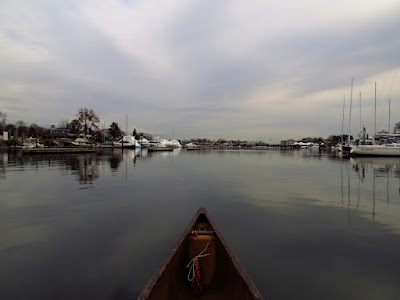It is only 35 degrees when I put in, but the wind is barely registering - decent winter paddling if you don't do something stupid.
The harbor is quiet with the oyster boats already out in the sound and no one else around except for a couple marina workers hauling out yachts. As a result, the harbor is active with wildlife - ten Great Blue Herons, forty Buffleheads, a dozen Mallards and two Common Loons before I get to open water. There is skim ice in the calmest areas of the harbor.
I decided that today was a good day to make my annual pilgrimage to Charles Island - the Mt. Rainier of Milford. Less than a mile off shore, one can walk to it at low tide on a bar called a tombolo. A tombolo bar is created by waves wrapping around an island. If you time the tide correctly, you can walk out, circle the island, and walk back without getting your feet wet. Time it wrong and you get to sit on the island waiting for the next low tide. Every couple of years someone drowns out there, either trying to wade back across the tombolo and getting carried off by the tide or flipping a canoe or kayak with their PFD securely stuffed in the bottom of the boat where it is absolutely of no use.
 |
| Charles Island with the tombolo leading out |
At the mouth of the harbor, I turn right and follow the shore in calm water. Although I'm 150 yards from the beach, I'm in 2 to 3 feet of water most of the time - if you flip a canoe in freezing water, it is nice if you can just stand up and get back in the boat, or walk to dry land. Winter paddling is all about having a plan B... and a plan C and D. On this route, if necessary, I can actually walk/tow the canoe from any point back to the harbor as long as I don't get blown away from shore. So, I follow the shore over to the tombolo, then I'll follow the tombolo out to the island, circle the island and return the way I came.
With the dropping tide the shore birds are feeding all along the newly exposed sections of the bar. It is mostly a mix of Sandpipers, Gulls, and Brandts. I do a short lift over the bar and into the windward water. The wind has come up and there is a good chop developing on that side. I keep moving as the conditions are changing and by the time I've rounded the little island there is a good wind in my face getting back to the bar. The calm water is gone, but the bar reduces the waves to "not much". But, it is a big angle crab along the bar as I paddle back to the shore. Then it is an almost casual drift with the wind back to the harbor. It was definitely time to not be on big water.














